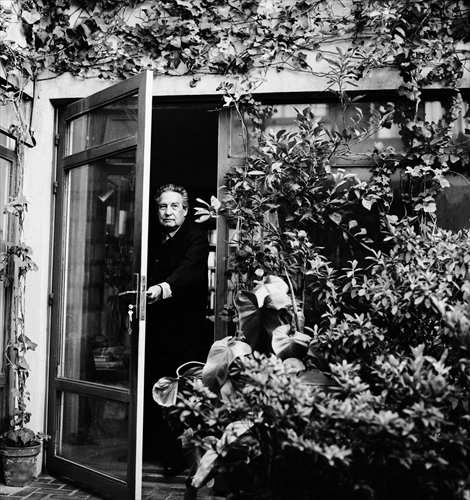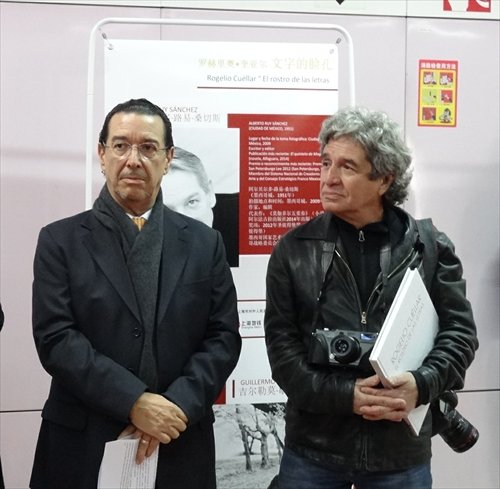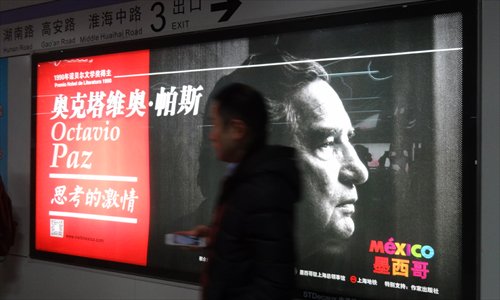HOME >> CHINA, METRO SHANGHAI
Poems for passengers
By Yang Lan Source:Global Times Published: 2015-1-19 18:48:01
Metro Line 10 passengers may have found themselves face to face with the late Mexican poet Octavio Paz over the past few days. The Nobel laureate's photograph and samples of his poetry, translated into Chinese, have adorned the interior of a Line 10 train since Thursday to expose more Chinese people to the poet's work, said Luis Arturo Puente Ortega, the Consul General of Mexico in Shanghai.
"Last year in Mexico, we celebrated the 100th anniversary of Octavio Paz's birth. We think that the cultural train is a great way for Chinese people to learn about this renowned writer," Ortega told the Global Times. "Paz had a great friendship with Chinese people. His works were translated into Chinese, and he translated the poems of great Chinese poets into Spanish, such as the poems of Wang Wei and Li Bai."
The train, dubbed the Octavio Paz Cultural Train, departed on its inaugural trip from Xintiandi Station to Shanghai Library Station at 3 pm Thursday. The rolling exhibition will run for 65 days.
Posters featuring Paz's photo and biography line the interior walls of the train. Plastic-encased placards featuring Paz's poetry hang from the handrails running horizontally across the car.
The Mexican consulate sponsored the train in cooperation with the Shanghai People's Association for Friendship with Foreign Countries and Shanghai Shentong Metro Group. Representatives from the organizations joined Ortega on the train's inaugural trip.
Paz was an important poet, writer and translator. He won the 1990 Nobel Prize in Literature, the 1982 Neustadt International Prize for Literature and the 1981 Miguel de Cervantes Prize. He published his first poems in the magazine Barandal (1931) when he was 17 years old, according to www.cervantes.es.
A selection of his poems was also translated into Chinese and published in China, including his famous poem Sunstone.
Paz's biography on the train said that he studied in the US for a year on a Guggenheim scholarship. In 1945, he entered Mexican diplomatic service and was sent to Paris. During his diplomatic career, he spent short periods in Japan, Switzerland and India.
Rogelio Cuellar, the famous Mexican photographer who shot portraits of Paz, also joined the inaugural trip. All the photos of Paz exhibited in the train were shot by Cuellar.
Cuellar's series named "The face of literature (El rostro de las letras)" featuring famous Mexican writers will be exhibited at Xintiandi Station.
Cuellar, a prestigious Mexican photographer, spent 47 years shooting portraits of great writers of different generations in Mexico. He photographed Paz at different times over a 23-year period. "From my photos, people can see the spirit and the personality of the writers," Cuellar told the Global Times.
It was the third time Cuellar visited China. His first trip was in 2005. Over the past 10 years, he has seen Chinese people experience great changes. "I see a modern and positive China. It can be seen in people's faces, in their work and in their art. I feel a lot of life and effervescence," he said. Cuellar has shot many photos of the urban and rural landscapes, but portraits have always been an important part of his work. Last May, an exhibition of his portraits of Chinese faces appeared in Hangzhou, Zhejiang Province.
While talking with the Global Times, Cuellar kept shooting. He stopped a professor attending the inaugural trip and took several photos of him. All the while, he kept saying that he needed more.
To encourage more Chinese people to read Paz's work, Ortega donated a collection of the writer's books and one book about Cuellar's works to Shanghai Shentong Metro Group and the Shanghai Library at the end of the trip.
The Mexican consulate in Shanghai is also planning a series of activities that it hopes will help Chinese people learn more about Mexico.




"Last year in Mexico, we celebrated the 100th anniversary of Octavio Paz's birth. We think that the cultural train is a great way for Chinese people to learn about this renowned writer," Ortega told the Global Times. "Paz had a great friendship with Chinese people. His works were translated into Chinese, and he translated the poems of great Chinese poets into Spanish, such as the poems of Wang Wei and Li Bai."
The train, dubbed the Octavio Paz Cultural Train, departed on its inaugural trip from Xintiandi Station to Shanghai Library Station at 3 pm Thursday. The rolling exhibition will run for 65 days.
Posters featuring Paz's photo and biography line the interior walls of the train. Plastic-encased placards featuring Paz's poetry hang from the handrails running horizontally across the car.
The Mexican consulate sponsored the train in cooperation with the Shanghai People's Association for Friendship with Foreign Countries and Shanghai Shentong Metro Group. Representatives from the organizations joined Ortega on the train's inaugural trip.
Paz was an important poet, writer and translator. He won the 1990 Nobel Prize in Literature, the 1982 Neustadt International Prize for Literature and the 1981 Miguel de Cervantes Prize. He published his first poems in the magazine Barandal (1931) when he was 17 years old, according to www.cervantes.es.
A selection of his poems was also translated into Chinese and published in China, including his famous poem Sunstone.
Paz's biography on the train said that he studied in the US for a year on a Guggenheim scholarship. In 1945, he entered Mexican diplomatic service and was sent to Paris. During his diplomatic career, he spent short periods in Japan, Switzerland and India.
Rogelio Cuellar, the famous Mexican photographer who shot portraits of Paz, also joined the inaugural trip. All the photos of Paz exhibited in the train were shot by Cuellar.
Cuellar's series named "The face of literature (El rostro de las letras)" featuring famous Mexican writers will be exhibited at Xintiandi Station.
Cuellar, a prestigious Mexican photographer, spent 47 years shooting portraits of great writers of different generations in Mexico. He photographed Paz at different times over a 23-year period. "From my photos, people can see the spirit and the personality of the writers," Cuellar told the Global Times.
It was the third time Cuellar visited China. His first trip was in 2005. Over the past 10 years, he has seen Chinese people experience great changes. "I see a modern and positive China. It can be seen in people's faces, in their work and in their art. I feel a lot of life and effervescence," he said. Cuellar has shot many photos of the urban and rural landscapes, but portraits have always been an important part of his work. Last May, an exhibition of his portraits of Chinese faces appeared in Hangzhou, Zhejiang Province.
While talking with the Global Times, Cuellar kept shooting. He stopped a professor attending the inaugural trip and took several photos of him. All the while, he kept saying that he needed more.
To encourage more Chinese people to read Paz's work, Ortega donated a collection of the writer's books and one book about Cuellar's works to Shanghai Shentong Metro Group and the Shanghai Library at the end of the trip.
The Mexican consulate in Shanghai is also planning a series of activities that it hopes will help Chinese people learn more about Mexico.

Octavio Paz
Photo: Courtesy of Rogelio Cuellar

Luis Arturo Puente Ortega, the Consul General of Mexico in Shanghai (left) and Mexican photographer Rogelio Cuellar at the inaugural ceremony

A placard that features Paz's poetry on a Line 10 train

A poster at Shanghai Library Station
Photos: Yang Lan/GT
Posted in: Society, Metro Shanghai